Part 1: DAC – Audio Decoder
When it comes to digital audio systems, the DAC (Digital-to-Analog Converter) is its heart. This is the part responsible for converting digital signals into analog sounds that we can hear. However, choosing and using a DAC is not a simple matter, because it involves many technical factors that can directly affect the sound quality. In this article, we will learn about the two most popular types of decoding chips, signal processing methods, and factors that affect DAC quality.
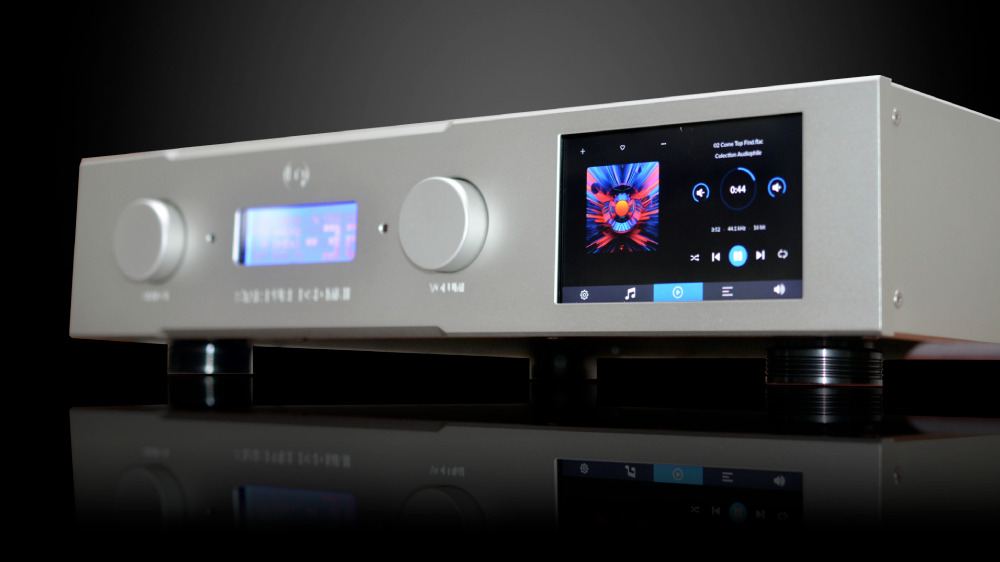
1. What is DAC and Why is it Important?
DAC, or digital-to-analog decoder, plays an extremely important role in processing audio signals from source devices (such as CD players, computers, HDPs) and converting them into analog signals that speakers can play. If the decoding process is not accurate, the sound quality will be degraded, leading to a poor listening experience.
DAC decoders usually include three main parts:
Data reception part (USB, SPDIF, Firewire, I2S)
Decoding chip (converts digital signals to analog)
Analog circuit (including power supply circuit and amplifier circuit)
2. Two Main Types of Decoding Chips: R2R and Delta-Sigma
R2R Chip: Accurate Decoding, But High Cost

R2R (Multibits Digital Analogue Converter) chips are passive decoders that use a precision resistor system to generate an analog signal. For example, a 16-bit chip has 16 electronic "keys", each of which generates a current of different magnitude depending on the position of each bit (LSB and MSB). Thanks to this principle, R2R chips are capable of reproducing signals very faithfully, less affected by external factors such as jitter.
However, the production of R2R chips requires high precision in the manufacturing process, making the production cost very expensive. This makes it difficult for audio manufacturers to widely apply this chip in consumer products, especially in mainstream DACs. For this reason, R2R chips are currently mainly used in medical and military applications where absolute precision is required.
Delta-Sigma Chips: Popular and Easy to Build
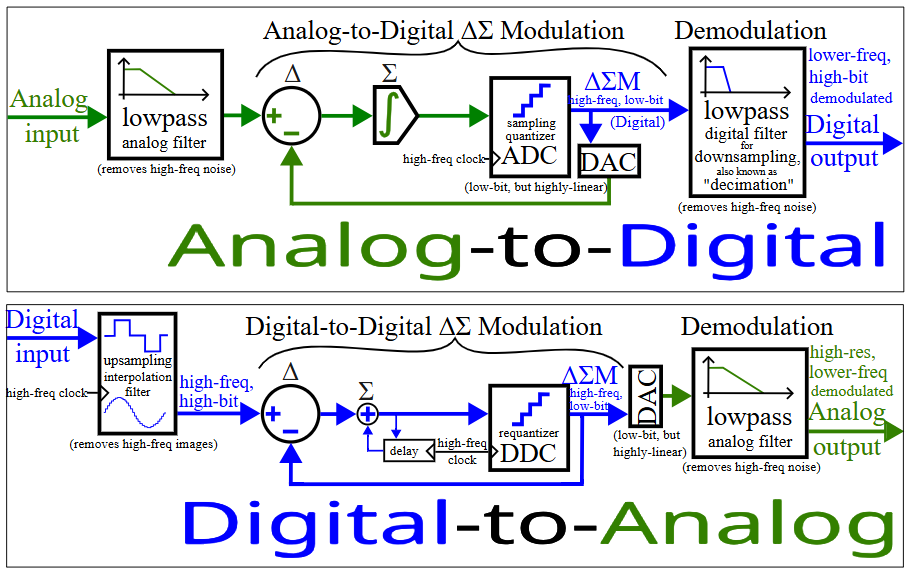
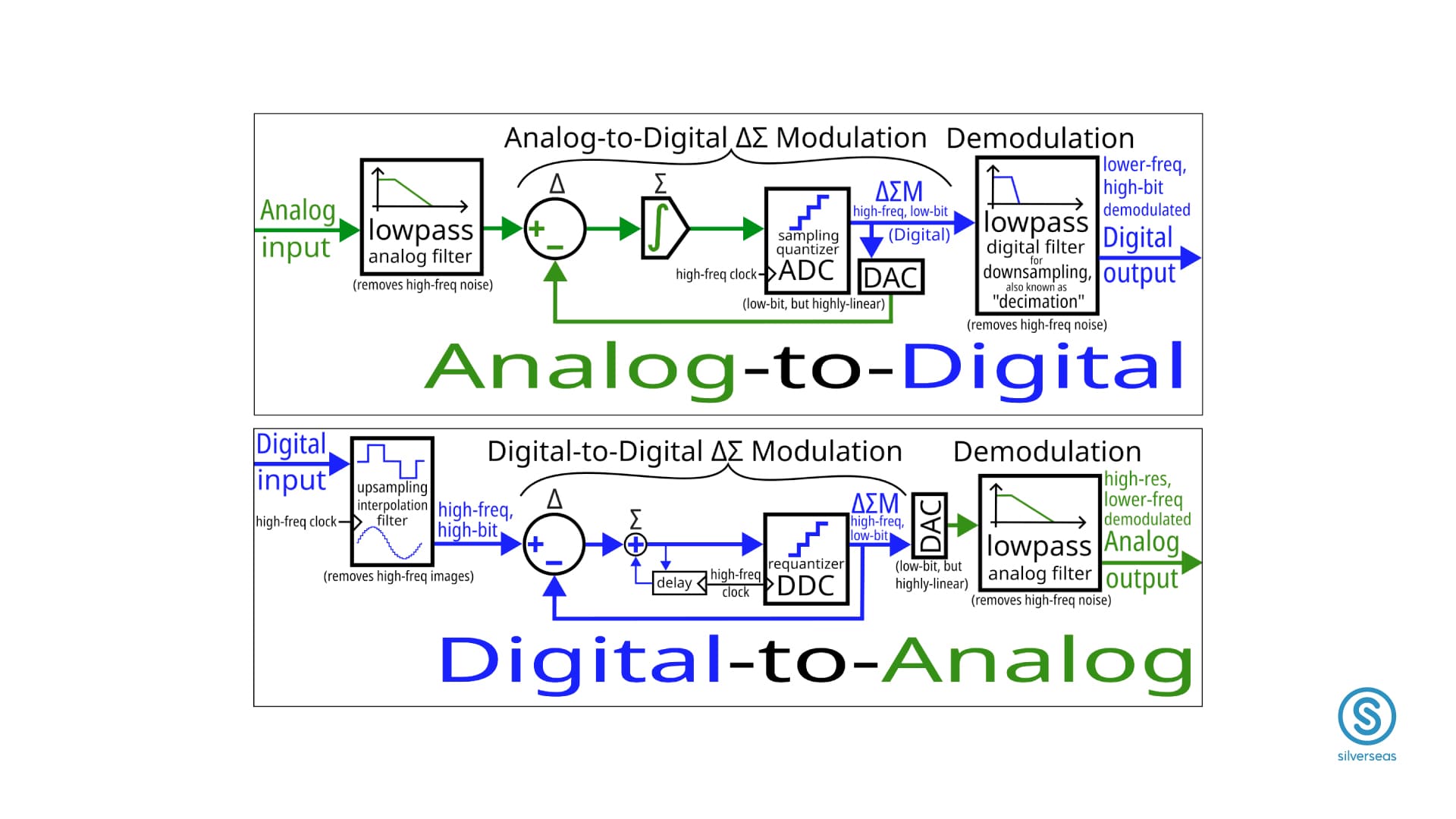 The Delta-Sigma (Timeslicing Digital Analog Converter) chip uses a different method: it generates an analog signal by repeatedly turning a switch on and off at a very high frequency, creating small pulses. However, this can create high-frequency noise, so algorithms such as noise-shaping and oversampling must be used to minimize this noise. This principle helps to create a DSD (Direct Stream Digital) signal.
The Delta-Sigma (Timeslicing Digital Analog Converter) chip uses a different method: it generates an analog signal by repeatedly turning a switch on and off at a very high frequency, creating small pulses. However, this can create high-frequency noise, so algorithms such as noise-shaping and oversampling must be used to minimize this noise. This principle helps to create a DSD (Direct Stream Digital) signal.
Although Delta-Sigma is easier to build and cheaper to manufacture, it is susceptible to jitter (signal distortion) due to unstable pulse frequencies. Therefore, DACs using Delta-Sigma chips need to have a very precise clock circuit to ensure sound quality.
3. Upsampling and Oversampling: Why is it Necessary?
One of the common questions when using a DAC is whether upsampling (upgrading the signal to a higher frequency) is necessary? In fact, almost all modern DACs, whether using R2R or Delta-Sigma chips, have upsampling or oversampling algorithms. Especially for Delta-Sigma chips, upsampling is almost a mandatory requirement to improve sound quality.

 Why Upsampling?
Why Upsampling?
When a digital signal is decoded, it still contains some high-frequency noise. If left untreated, this noise will degrade the sound quality. Upsampling increases the bandwidth of the signal, making it easier for high-frequency filters to cut off while still maintaining the natural sound. For example, when the signal is upscaled to 176 kHz, the noise and high-frequency cutting will be more effective than using only 44.1 kHz bandwidth.
What is the difference between Upsampling and Oversampling?
Oversampling is a process that is performed directly on the decoding chip (increasing the sample frequency right on the chip).
Upsampling is a process that uses software or hardware to create a new signal with a higher frequency before sending it to the DAC.
If you use high-quality software or hardware for upsampling, the results will be much better. However, not all software does this effectively. For example, Signalyst HQPlayer's filter is highly rated, while software like foobar or JRiver often cannot produce good results.
4. What Does DAC Quality Depend On?
The quality of a DAC depends not only on the decoding chip but also on many other factors such as analog circuit design, power supply, signal receiving circuit and firmware. According to statistics, the quality of a DAC is only about 20% due to the chip, the rest is due to other factors. Leading brands often design separate filters, which helps improve sound quality compared to using the default filter available in the chip.
5. Is R2R DAC Better Than Delta-Sigma?
Although R2R chips are highly rated in high-end DACs (with prices ranging from several thousand USD or more), they are not always superior to Delta-Sigma chips. In fact, there are DACs that use Delta-Sigma chips but still produce very good sound quality, especially when the circuit design and filters are optimized.
However, high-end DAC products such as Total DAC, dCS Debussy, and LH Labs De Vinci often use R2R chips and cost up to tens of thousands of dollars, targeting audiophiles and audiophiles.
6. Conclusion
Choosing a suitable DAC depends not only on the type of chip but also on many other factors such as circuit design, signal processing, and software algorithms. If you are an audiophile looking for a high-quality DAC, pay attention to famous brands and flagship products that use R2R chips or have proprietary circuit designs to ensure the best sound quality.
In addition, upsampling or oversampling can help improve sound quality, but it is important to choose software or hardware that is powerful enough to process the signal accurately.
Pay attention to these factors when choosing a DAC for yourself, and you will have a great sound experience!
Part 2: Digital Audio Signal
After learning about DAC decoders, we will next explore digital audio signals (Digital Audio). In the field of digital audio, there are two main formats: PCM (Pulse Code Modulation) and DSD (Direct Stream Digital), each with its own characteristics and applications. However, there are many interesting things about these two audio standards that few people know.

1. Why was the first audio standard for digital music 16 bits, 44.1kHz?
This is a question that many people, including myself, have asked themselves. The reason is actually quite simple: 16 bits was the optimal choice at that time because R2R decoder chips were limited in their manufacturing capabilities, and in 1982, 16 bits was the highest level that these chips could achieve.
As for 44.1kHz, although in theory, choosing this frequency was not the most optimal from a technical perspective, it was a compromise between sound quality requirements and economic factors. Engineers at Phillips and Sony knew that cutting frequencies above 22kHz would lose some of the audio information that the human ear could still perceive. However, the practical problem is that increasing the sample rate will increase the capacity and size of the audio file, making it difficult to store on a CD. Furthermore, if the sample rate is increased to 88.2kHz or higher, manufacturers will have to change the structure of the CD, increasing the production cost, which is not economically attractive. Therefore, 44.1kHz is chosen as a compromise: it meets the Nyquist technical requirements (twice the audible frequency range of the human ear), but maintains a moderate capacity and storage capacity on a CD.
2. So how many audio bits are enough?
In fact, 32-bit music is a concept that does not exist in music, because even with today's best microphones, the dynamic range of the signal is only up to about 140dB, equivalent to 24 bits of audio. Unless it is a recording for special instrumental works, for popular music such as traditional music, folk music, 18 bits is enough to reproduce detailed and accurate sound.
Regarding whether 24-bit music is the original sound or not, most of these files are the result of upsampling from 16 bits, because in the 1980s and 1990s, R2R decoding chips were not yet developed enough to decode signals with a resolution higher than 18 bits. 24-bit files that appeared later may be recordings converted from analog to digital, but there are also many cases where they are just upsamples from 16-bit signals. Therefore, when listening to 32-bit music online, it is very likely that the file has been upsampled from 24 bits or 16 bits.
A typical example is the R2R chip used in high-end DACs (such as Schiit Audio's Yggdrasil DAC), which, although very expensive, still only achieves 21 bits. Therefore, the concept of 32-bit music as a reality in digital audio is an incorrect one.
3. The birth of DSD
DSD was not born out of a need to correct errors in PCM, but because Sony itself wanted to solve their problem. At that time, Sony owned a huge music library after acquiring CBS and RCA, but with fragile analog tapes, they needed a safer and more durable storage method. That's why they developed DSD, using the Delta-Sigma algorithm. DSD was born with the purpose of keeping the sound quality almost equal to the original on analog tape, and making storage safer.
4. DSD or PCM: Which is better?
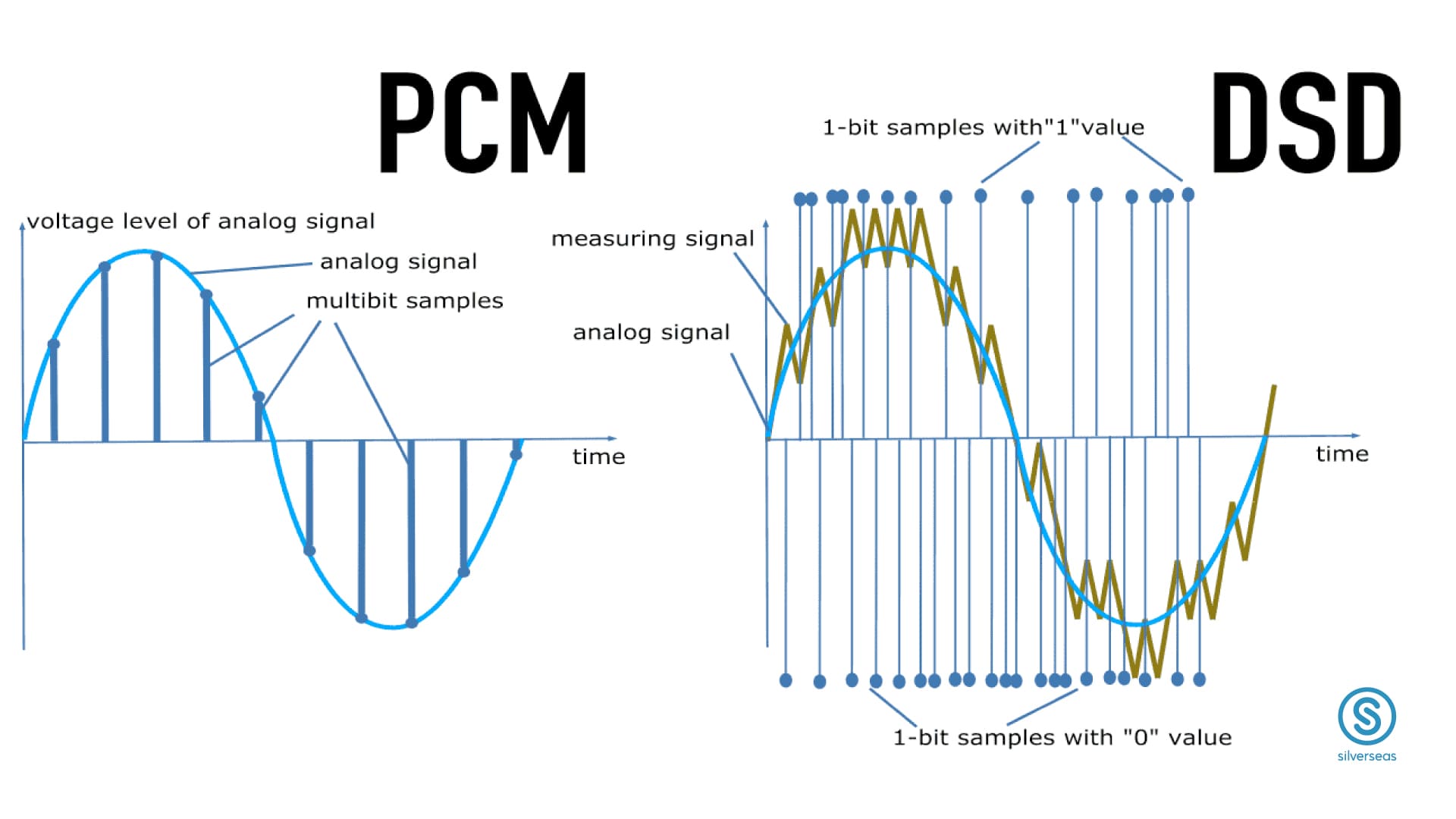
1. Why was the first audio standard for digital music 16 bits, 44.1kHz?
This is a question that many people, including myself, have asked themselves. The reason is actually quite simple: 16 bits was the optimal choice at that time because R2R decoder chips were limited in their manufacturing capabilities, and in 1982, 16 bits was the highest level that these chips could achieve.
As for 44.1kHz, although in theory, choosing this frequency was not the most optimal from a technical perspective, it was a compromise between sound quality requirements and economic factors. Engineers at Phillips and Sony knew that cutting frequencies above 22kHz would lose some of the audio information that the human ear could still perceive. However, the practical problem is that increasing the sample rate will increase the capacity and size of the audio file, making it difficult to store on a CD. Furthermore, if the sample rate is increased to 88.2kHz or higher, manufacturers will have to change the structure of the CD, increasing the production cost, which is not economically attractive. Therefore, 44.1kHz is chosen as a compromise: it meets the Nyquist technical requirements (twice the audible frequency range of the human ear), but maintains a moderate capacity and storage capacity on a CD.
2. So how many audio bits are enough?
In fact, 32-bit music is a concept that does not exist in music, because even with today's best microphones, the dynamic range of the signal is only up to about 140dB, equivalent to 24 bits of audio. Unless it is a recording for special instrumental works, for popular music such as traditional music, folk music, 18 bits is enough to reproduce detailed and accurate sound.
Regarding whether 24-bit music is the original sound or not, most of these files are the result of upsampling from 16 bits, because in the 1980s and 1990s, R2R decoding chips were not yet developed enough to decode signals with a resolution higher than 18 bits. 24-bit files that appeared later may be recordings converted from analog to digital, but there are also many cases where they are just upsamples from 16-bit signals. Therefore, when listening to 32-bit music online, it is very likely that the file has been upsampled from 24 bits or 16 bits.
A typical example is the R2R chip used in high-end DACs (such as Schiit Audio's Yggdrasil DAC), which, although very expensive, still only achieves 21 bits. Therefore, the concept of 32-bit music as a reality in digital audio is an incorrect one.
3. The birth of DSD
DSD was not born out of a need to correct errors in PCM, but because Sony itself wanted to solve their problem. At that time, Sony owned a huge music library after acquiring CBS and RCA, but with fragile analog tapes, they needed a safer and more durable storage method. That's why they developed DSD, using the Delta-Sigma algorithm. DSD was born with the purpose of keeping the sound quality almost equal to the original on analog tape, and making storage safer.
4. DSD or PCM: Which is better?
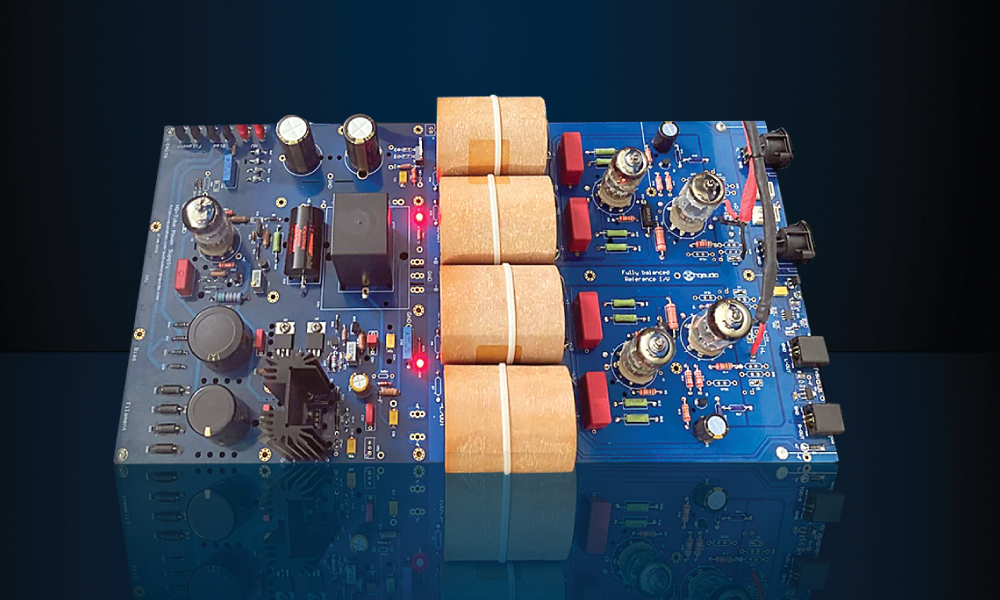
The analog circuit in a DAC consists of two main parts: the IV circuit (current to voltage converter circuit) and the amplification circuit. The IV circuit is responsible for converting the signal from current to voltage, because after the audio chip decodes the signal, the signal will be output in the form of current, while the amplification circuit needs to work with voltage. The quality of the IV circuit is very important, because if the signal is disturbed here, when amplified, it will lead to distorted sound and loss of detail.
Many current decoding chips have built-in op-amps to perform the current to voltage conversion. However, DAC designers often do not use integrated op-amps, because the quality of these op-amps is often not high, and can reduce the sound quality. Instead, they use external IV conversion circuits and analog frequency filters to maintain the purity and fidelity of the signal.
As for the amplifier circuit, there are two main schools: using semiconductor and using tube amps. Semiconductor amplifier circuits are low cost and high efficiency, while tube circuits often bring a warmer and smoother sound quality, which is loved by many people because of the analog nature of the sound. Some famous brands such as Lampizator (with high-priced DACs from 1000-7000 USD) specialize in producing DACs using tube amplifier circuits, bringing a characteristic and emotional sound.
3. New Trend in the Next Five Years: The Revival of R2R DAC
In the past, R2R (Resistor Ladder DAC) chips were forgotten due to high production costs and complexity in circuit design. However, with the development of technology, the trend of using R2R DACs is making a strong comeback in the audiophile community.
One of the factors that makes R2R chips popular is the faithful and detailed sound quality. Compared to Delta-Sigma chips, although capable of expressing details, especially in the treble range, Delta-Sigma chips often lack power in the bass and treble ranges. Furthermore, Delta-Sigma chips have difficulty reproducing the resonance of musical instruments and sounds that reverberate in space, such as the resonance of a piano or a cymbal, making them sound like noise. Meanwhile, R2R DACs reproduce these sounds naturally and clearly, helping listeners feel the sound more realistic.
In the 1980s and 1990s, R2R chips only had a resolution of 16 bits. However, currently, Texas Instruments' PCM1704UK chip, although it can handle 24-bit music files, is still quite outdated in quality and has not been improved in the past 10 years. Some DAC manufacturers, such as Audio GD, have used the PCM1704UK in their products, but have encountered problems with feasibility and efficiency.
The new direction for R2R chips was taken by Schiit Audio, with leading engineers such as Mike Moffat (founder of Schiit and the man behind famous DACs such as Theta). Instead of using old R2R chips, Schiit looked for new R2R chips, used in fields such as medical or military, which require extremely high precision. The result is the Schiit Yggdrasil, a $2300 R2R DAC that is considered a "game changer" in the audio industry. The Yggdrasil outperforms high-end Delta-Sigma DACs such as PSAudio Directstream, Auralic Vega and Chord Hugo in terms of fidelity and sound reproduction.
Not stopping there, Schiit also upgraded other DAC lines such as Gungnir and Bifrost to R2R chips, helping audiophiles experience the sound quality of R2R DACs at a more affordable price.
5. Summary of DACs
1. Many People Think CD Players Sound Better Than DACs
A CD player is an integrated device, including a mechanical part and a DAC, which can deliver good quality sound thanks to the design of a closed system, minimizing interference and stabilizing the signal. However, a CD player cannot be compared to a digital music playing solution using a computer combined with a modern DAC, especially when the computer can upgrade components, change the power source and make hardware adjustments to reduce interference and improve sound quality.
For example, for around $1500 you could buy a new CD player, but instead you could spend $400 on computer upgrades (e.g. power supply and motherboard optimization) and $1100 on a good DAC (like Audio GD DAC-19, Schiit Gungnir, Yulong DA8). The sound quality this solution delivers will be far superior to a CD player in the same price range. Furthermore, the DAC allows you to listen to recordings in different qualities such as 16 bit, 24 bit, 96 kHz, DSD, instead of just being limited to CDs.
However, if you only listen to a few CD albums and are not interested in upgrading, a CD player is still a great choice because of its convenience and ease of use.
2. DAC Quality and DAC Price Trends in the Market
About 5 years ago, the quality of DACs in the mid-range and low-end segments was still quite weak, mainly because the Jitter processing problem had not been effectively solved. However, with the advent of asynchronous USB technology in 2011, DAC quality has improved significantly, making old products such as Cambridge DacMagic become "low-end" products while compact DACs such as Audioquest Dragonfly or iFi iDSD

In a music listening system, the sound quality is distributed as follows: Transport takes up 2 parts, DAC takes up 3 parts, Amplifier takes up 2 parts, and Speakers/Headphones take up 3 parts. Each component in the system has its own important role:
Transport: A good transport will ensure that the signal is transmitted from the source to the DAC accurately and without interference.
DAC: This is the part that decodes the digital signal into analog sound in a faithful and detailed manner.
Amplifier: Amplifier helps amplify the signal and provide enough power to the speaker. However, the amplifier cannot increase the ability to reproduce small details in the sound, such as the resonance of the voice or piano.
Speakers/Headphones: Good speakers will reproduce sound over a wide range and as naturally as possible.
In addition, the software for the DAC (or firmware) also plays an important role in the sound quality. Firmware affects the frequency filters, optimizes the input signal and reduces jitter, accounting for about 20% of the quality of the DAC. The rest comes from circuit design and component quality, which accounts for 50% of the overall quality of the DAC.
Conclusion
Although CD players and discrete DACs have their own advantages and disadvantages, discrete DACs often provide better sound quality and are more flexible in supporting digital music formats. My personal opinion is that using a discrete DAC will be the optimal choice in many cases, especially when you want detailed sound and can invest in upgrading the system. However, this view is still limited and needs to be carefully considered based on each person's needs and budget.
Hope you will find the right choice for your requirements and look forward to receiving your feedback to improve it!
Please watch the video